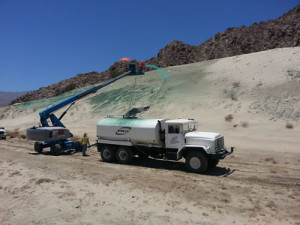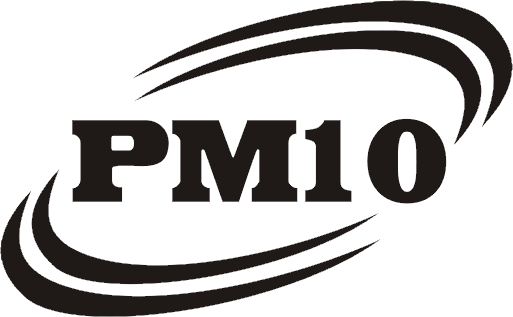Erosion Control – Hydroseeding
Hydraulic Mulch Seeding, Hydro-Mulching, Hydraseeding California by PM10 Inc.
 Hydroseeding (or hydraulic mulch seeding, hydro-mulching, hydraseeding) is a planting process which utilizes a slurry of seed and mulch. The slurry is transported in a tank, either truck or trailer mounted and sprayed over prepared ground in a uniform layer; helicopters may be used in cases where larger areas must be covered. Hydroseeding is an alternative to the traditional process of broadcasting or sowing dry seed. It promotes quick germination and inhibits soil erosion.
Hydroseeding (or hydraulic mulch seeding, hydro-mulching, hydraseeding) is a planting process which utilizes a slurry of seed and mulch. The slurry is transported in a tank, either truck or trailer mounted and sprayed over prepared ground in a uniform layer; helicopters may be used in cases where larger areas must be covered. Hydroseeding is an alternative to the traditional process of broadcasting or sowing dry seed. It promotes quick germination and inhibits soil erosion.
The mulch in the hydro seed mixture helps maintain the moisture level of the seed and seedlings. The slurry often has other ingredients including fertilizer, tackifying agents, green dye and other additives.
Hydroseeding is used to seed grass on commercial sites (highways/motorways etc.), golf courses, lawns and areas too large, inaccessible or unsuitable for conventional methods. Starting a lawn by hydroseeding is considerably cheaper than laying sod/turf and quicker than using seed. It is also used to spread mixtures of wildflower and tree/shrub seeds or turf grasses for erosion control. The process is called sprigging (or hydro-sprigging) when the slurry contains stolons or rhizomes instead of seed.
Why Hydroseed?
Cost Effective
Hydroseeding is the most economical choice for establishing the desired turf without the expense, time, material costs or installation demands of sodding or traditional hand seeding methods.
Quality
The lawn quality that hydroseeding affords is much healthier, greener and longer lasting than sodding or hand seeding applications because the root establishment is deeper into the soil and avoids the shock of being transplanted into foreign soils.
Coverage
Hydroseeding provides a thicker, more uniform lawn that essentially consists of a mat of interlocking fibers creating the ideal growing environment that doesn’t have the threat of seams showing as with sod or sparse, patchy areas with hand seeding.
Erosion Control
Erosion control is the most prevalent commercial reason for using hydroseeding. Hold moisture and protect against soil loss from wind, rain, sun and pests through the binding of seed, mulch, tackifiers and other soil conditioners that encompass the hydroseeding slurry which binds with the surface soil.
Versatility
Hydroseeding has become increasing popular, overshadowing both hand seeding and sod, for a wide array of jobsites and applications, including residential and commercial landscapes, hillside stabilizations, vegetation restorations, golf courses, landfills, wildfire repairs, mine reclamations, and schools and parks.
Health
Hydroseeding creates the ideal microenvironment for germinating seed because the slurry materials enhance the process and stimulate the seeds to grow a healthy, deep-rooted system in the ground where moisture is at its greatest.
Speed
Although hydroseeding doesn’t afford an “instant lawn” gratification, the combination of cost, quality, coverage, erosion control and health definitely tip the scales in favor of the plentiful benefits of hydroseeding. Hydroseeding is faster and easier to install than sod, and this rapid application is managed without the downfall of extensive labor expenditures.
Safety
Hydroseeding is a completely safe and non-toxic method of growing grass that is harmless to kids, pets, and the environment.
Labor
One of the major advantages of hydroseeding is simply manpower. In a typical hydroseeding application, 3 workers can accomplish what is would generally take 6 workers to fulfill given the same amount of work time using erosion blankets or sod.
Water
With hydroseeding’s ability to retain up to 10 times its weight in water, it’s definitely proved to be the best method for fast, healthy germination, high plant survival and protection of seeds with a moisture sealant. No other method of growing grass has this water retention advantage.
